Pages 519-524
A History of the County of Hampshire: Volume 4. Originally published by Victoria County History, London, 1911.
This free content was digitised by double rekeying. All rights reserved.
In this section
WEST TYTHERLEY
Tederleg (xi cent.); Tyderle, Chuderleg, Westhuderleg, Westiderleg, Tuderlegh (xiii cent.); West Uderle, Westaderle, Westerdeley (xiv cent.); West Tyderley, Westytherley (xvi cent.).
The parish of West Tytherley contains 2,918 acres, of which 1,089¾ acres are arable land, 961¼ acres permanent grass and 710½ acres woodland. (fn. 1)
The village is almost in the centre of the parish; at its southern end is the church, built in 1833 in place of a church which stood a few yards from the present site.
Norman Court, a large house restored by the late Mr. Thomas Baring and now occupied by Mr. Washington Singer, is in the north-west corner of the parish, and is surrounded by a well-wooded park of more than 150 acres. South of the park and on the road from West Tytherley village to the common there are six almshouses, each with a garden, for old people.
Over the western boundary of the shire and parish is a detached portion of Winterslow which formed part of the great serjeanty of West Tytherley in the 13th century. (fn. 2)
By an Order in Council of March 1883 the Hampshire portion of West Dean parish, which until 1474 was a separate Hampshire parish called West Dean All Saints, was amalgamated with West Tytherley. The county boundary also underwent slight change, and the site of All Saints' Church is now in Wiltshire.
The soil is clay and chalk, and the subsoil chalk. The chief crops are wheat, barley and oats.
Buckholt (Bocholt, Bokolt, xiii cent.; Boucholte, Bokholte, Blockholt, Brokholt, xiv cent.), formerly extra-parochial, is now a separate civil parish lying to the north of the Tytherleys; it contains 1,102 acres, of which 433½ are arable, 370¾ permanent grass and 50 woodland. (fn. 3) There is no church, and the only dwelling-places are Buckholt Farm and some cottages. Queenwood College, which stood on the border of East Tytherley parish, was entirely demolished about 1903, after having been partially destroyed by fire. This building, at first called Harmony Hall, was built in 1841 as the home of a socialistic community under Robert Owen. The scheme soon failed and the place was left unoccupied till 1847, when the building, together with the farm of 600 acres, passed into other hands. It was afterwards used for a school, which was given up at the beginning of 1896; here Tyndall and Frankland held appointments and Professor Fawcett was a pupil.
The Roman road from Winchester to Sarum runs past Buckholt Farm and through the southern part of the parish. Cold Harbour, the site of mediaeval glass-works, lies a little to the north, and the remains of glass-works are also to be found near Hassock. (fn. 4) In the north-eastern part of the parish, not far from Broughton Down, is a tumulus known as the Turret.
A few fine specimens of the beech-tree, from which Buckholt is said to have derived its name, are still to be found, but the site of the forest is now occupied principally by rolling downs, hardly cultivated. The soil is clay and light loam, and the subsoil chalk. The chief crops are wheat, barley, oats and turnips.
Manors
The manor of WEST TYTHERLEY is perhaps represented by the land which is said in Domesday Book to have been held of King Edward as three manors by three freemen, two of whom were killed at the battle of Hastings (fn. 5); this estate belonged at the time of the Survey to Alwi the son of Turber, but his right to it was disputed by the men of the hundred, who declared that they had never seen his predecessor Alwin Ret given seisin, and that unless the king bore witness to his claim he had nothing there. (fn. 6)
At the beginning of the 13th century West Tytherley was held of the king by Geoffrey de Porton and Richard de Cardeville, who both held in serjeanty, viz. by the service of a mounted serjeant, with hauberk, iron cap and lance, for forty days within the realm of England. (fn. 7) On the death of the former in 1220 his moiety passed to his brother, Robert de Porton, (fn. 8) who died six years later, leaving as heirs his nephew Walter de Langford and his niece Maud daughter of Gilbert and wife ot Hugh de Burguynon. (fn. 9) The estate in West Tytherley was apparently assigned to Walter, and from him passed before 1253 (fn. 10) to his son Roger de Langford, who was succeeded before 1272 by a Walter de Langford, probably his son. The latter granted his moiety of the manor, in exchange for the manor of Little Winterbourne (co. Wilts.), (fn. 11) for life to Robert Waleran, who died m 1272, leaving a minor as his heir. (fn. 12) The estate in West Tytherley was then taken into the king's hands, but was afterwards restored to Walter de Langford on condition that the manor of Little Winterbourne should be kept for the king's use until the heir of Robert Waleran came of age. (fn. 13)
In 1276 the custody of part of the lands which had belonged to Walter de Langford was granted during the minority of his daughter and heir Joan to Walter de Helyun at a rent of £9 9s. (fn. 14) He surrendered the lease four years later, and a fresh grant was made to Hugh Escote, (fn. 15) who had married Joan the heiress of Walter. (fn. 16) She died seised of the estate in 1316, leaving a son and heir Walter, (fn. 17) who in 1333 obtained licence to settle his moiety of West Tytherley Manor on himself for life with remainder in fee-tail to Hugh, his son. (fn. 18) Walter died in 1342, (fn. 19) and in 1350 Hugh conveyed the land to William de Overton, (fn. 20) who died about 1361, leaving a son and heir Thomas. (fn. 21) Thomas died in August 1370 (fn. 22); his son Michael, who was born after his father's death, died a minor in 1389, (fn. 23) when the estate passed to Elizabeth the wife of Robert Tawke and daughter of Isabel the sister of Thomas. (fn. 24) It then remained in the Tawke family (fn. 25) until William Tawke died in 1504, leaving two daughters, of whom the younger, Joan, succeeded to his lands in West Tytherley, (fn. 26) and died in 1561, leaving as heir Humphrey, (fn. 27) her eldest son by her first husband, Richard Ryman. He left the estate at his death in 1568 to his son and heir John (fn. 28) who was holding in 1586, (fn. 29) but subsequently sold the estate to the Whiteheads, (fn. 30) a family which had been established at Norman Court in this parish since 1433.
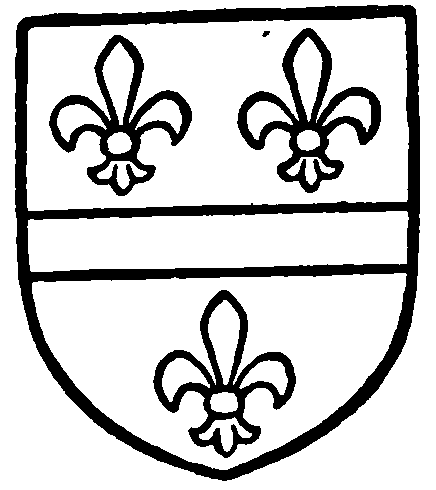
Whitehead. Azure a fesse between three fleurs de lis or.
Richard de Cardeville, who held the other moiety of West Tytherley Manor in the reign of Henry III, died about 1247, leaving as his heir his son Sir William de Cardeville. (fn. 31) Sir William died in 1254; he was succeeded by his son Richard, (fn. 32) who enfeoffed Richard Bukesgate and Isabel his wife of the estate. (fn. 33) Richard Bukesgate died in 1310 (fn. 34) and his wife in 1315 (fn. 35); their heir was their son Adam, who left his moiety of West Tytherley Manor, at his death in 1333, to his three daughters and co-heirs: Joan the wife of Thomas Bynedone, Helen the wife of Richard Bettesthorn, and Katherine the wife of Giles Escote. (fn. 36)
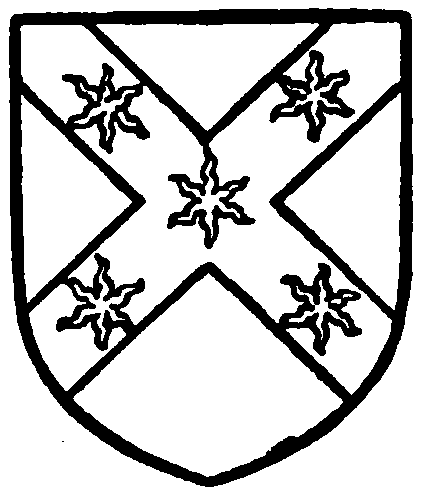
Bettesthorn. Argent a saltire gules with five stars or thereon.
William Frere, who may have been the grandson of Joan Bynedone, held part of a moiety of West Tytherley Manor in 1377 (fn. 37); it seems to have been bought before 1400 by the descendants of Helen and Katherine. (fn. 38)
Helen the wife of Richard Bettesthorn had three daughters and co-heirs, Agnes, Joan and Margaret. (fn. 39) The eldest, Agnes, married Henry Bradway, who survived her and died seised of her land in 1361, leaving as his heir their son John. (fn. 40) Joan and Margaret granted the reversion of their property in 1364 to John Bettesthorn, (fn. 41) who was seised in 1377 (fn. 42) and died in 1380, leaving a son and heir John, who died in 1399. (fn. 43) His heir was his daughter Elizabeth, the wife of Sir John Berkley, (fn. 44) who seems to have conveyed the land shortly after her father's death to her kinsman, John Bradway. (fn. 45) In 1400 John Bradway died seised of lands in West Tytherley which he held as parcel of the great serjeanty with Robert Tawke and William Escote; he left as his heir his daughter Katherine, then aged twelve. (fn. 46)
Katherine, the youngest daughter of Adam Bukesgate and wife of Giles Escote, died seised of a third part of the moiety of West Tytherley Manor in 1361, (fn. 47) leaving as her heir her son William, who in 1377 obtained leave to settle the estate in tail on his heirs by his wife Elizabeth. (fn. 48) William's descendants must have remained in possession of the land for more than a hundred years, for in 1508 Walter Escote, who was probably a great-grandson, settled on John Everard, the son of his daughter Margaret, his property in West Tytherley, (fn. 49) which apparently included at this date the other two-thirds of the moiety of which Adam Bukesgate had died seised. (fn. 50)
In 1519 Sir John Dawtrey died seised of this estate, (fn. 51) which was described as the 'manor' in a grant of the wardship of his son and heir Francis (fn. 52) : it cannot, however, have been the whole manor, for one moiety was then the property of the Rymans. Francis Dawtrey married Blanche, the kinswoman and heir of Robert Willoughby Lord Broke (fn. 53) : he was knighted by Henry VIII and made Sheriff of Dorset and Somerset in 1546, and of Hants (fn. 54) in 1548. Sir Francis seems to have sold the property before 1552, for in that year Thomas Welles died seised of it, leaving as his heir his son Gilbert. (fn. 55) About 1574 William Stanesby died seised of the estate and was succeeded by his brother John, (fn. 56) who may have sold it to the Whiteheads. (fn. 57)
In 1684 Richard Whitehead was the lord of the manor, (fn. 58) which subsequently followed the descent of Shirley in Millbrook until the beginning of the 19th century, when it was sold by the Thistlethwayte family to Charles Wall, (fn. 59) who on his death in 1815 was succeeded by his son Charles Baring Wall. The latter died unmarried in 1853 and the manor then passed in accordance with his will to his mother's nephew, Thomas Baring, (fn. 60) second son of Sir Thomas Baring, bart., her eldest brother. Thomas Baring, who was M.P. for Huntingdon, and head of the great mercantile house of Baring Brothers, died unmarried in 1873, (fn. 61) having devised his estates to his cousin William Henry Baring. (fn. 62) The latter's son, Mr. Francis Charles Baring, was lord of the manor in 1906, but subsequently sold it to Mr. Washington Singer, the present owner. (fn. 63)
The manor of WEST DEAN was held of the king in chief as part of the barony of Dean. (fn. 64) Before the Conquest Boda held it of King Edward as an alod, and after the Conquest it passed to Waleran the Huntsman, (fn. 65) whose descendants assumed the name of Waleran and held the manor (fn. 66) until the death of Walter Waleran about 1200. (fn. 67) He left three daughters: Cecily wife of John de Monmouth, Isabel wife of William de Nevill, and Aubree, who married firstly Robert de Pole, secondly John de Ingham and thirdly William de Botereaux. (fn. 68) John de Monmouth, son and successor of John and Cecily, was executed in 1280–1 for the murder of Adam de Gilbert, chaplain of Wells, and in 1305 his share of the manor was restored by the king to his cousins, the representatives of the other two daughters of Walter Waleran. (fn. 69)
Aubree de Botereaux died in 1269–70 and was succeeded by Oliver Ingham, her son by her second husband. (fn. 70) The manor descended from father to son in the Ingham family (fn. 71) until 1344, when Oliver Ingham died leaving co-heirs, his daughter Joan wife of Roger Lestrange, and his granddaughter Mary daughter of John Curzon. (fn. 72) Mary subsequently married Stephen Tumby and died in 1349–50 holding land at East Dean belonging to the barony of Dean, her heir being her aunt Joan Lestrange, (fn. 73) who married as a second husband Sir Miles Stapleton of Bedale. He died 1364–5 and his son Miles succeeded. (fn. 74) The property descended in the Stapleton family until the death of Sir Miles Stapleton, grandson of the last-named Miles, in 1466. He left co-heirs, his daughters Elizabeth wife of Sir William Calthorp and Joan wife of Christopher Harcourt. (fn. 75) There is no indication that any part of the manor passed to the Calthorps. In 1500 Miles Harcourt son of Christopher and Joan released all his claim in West Dean to Sir John Huddleston, his mother's second husband. (fn. 76) This was no doubt a quitclaim to Sir John for life, for this moiety of the manor remained in the Harcourt family until 1578–9, when it was sold by Walter Harcourt and his son Robert to Henry Giffard. (fn. 77)
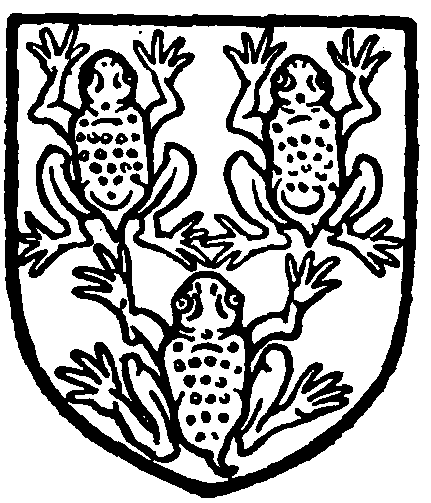
Botereaux. Argent three toads sable.
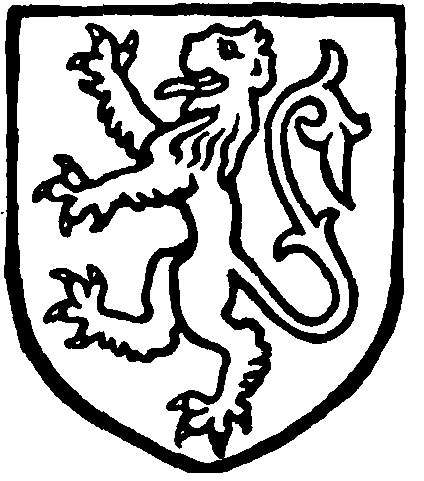
Stapleton. Argent a lion sable.

Harcourt. Gules two bars or.
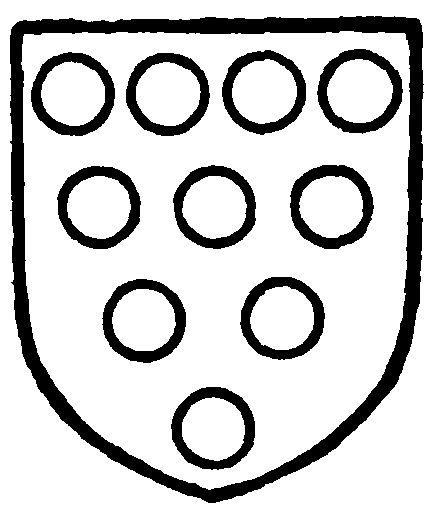
Giffard. Gules ten bezants.
The share of the manor held by Isabel wife of William Nevill passed from her to her daughter Joan, who married Jordan de St. Martin. (fn. 78) Joan, then called Joan de Nevill, died in 1263, when her son William de St. Martin succeeded to the estate. (fn. 79) William died in 1290–1, (fn. 80) and the estate passed from his son and successor Reginald in 1314–15 to his son Laurence. (fn. 81) The latter died in 1318, leaving two daughters, Sibyl and Joan, (fn. 82) but the estate was held by Sibyl widow of Laurence and afterwards wife of John de Scures until her death in 1349, when Laurence, a posthumous son of Laurence de St. Martin, succeeded to the moiety of the manor. (fn. 83) He died in 1385–6, leaving as his heirs his nephew Henry Popham son of his sister Sibyl, and his great-nephew Thomas son of Laurence Calston son of his second sister Joan. (fn. 84) The estate in West Dean was evidently assigned to Henry Popham, for he died seised of it in 1418–19, leaving Stephen his son and heir. (fn. 85) Stephen and his brother John both died without male issue, and the estate having been entailed on heirs male passed to their cousin John son of Sir John Popham. (fn. 86) He died in 1463 without issue, and his heirs were the four daughters of Stephen Popham above named. (fn. 87) This property in West Dean was assigned to Elizabeth wife of John Barentyn. (fn. 88) John's grandson William Barentyn (fn. 89) sold the estate to Sir William Essex, who died seised of it 1550–1. (fn. 90) The moiety of the manor was sold in 1571–2 by Thomas Essex, probably the grandson of William, to James Yate of Upham, (fn. 91) who died in 1576, leaving as his heirs his kinsfolk Arthur Whitehart, John Bright, John Simpson, Clara Jones, Jane Baker, and Joan Haines, (fn. 92) by whom the manor was sold in 1577 to Henry Giffard. (fn. 93)
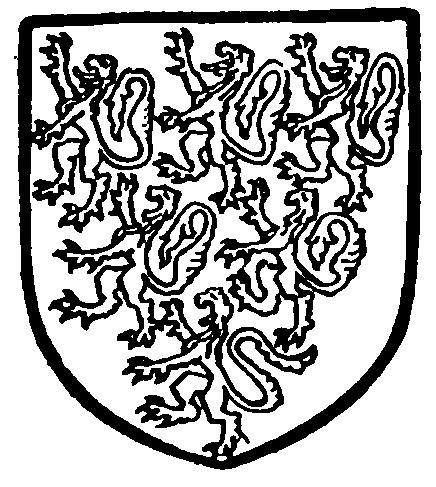
St. Martin. Sable six lions or.

Popham. Argent a chief gules with two harts' heads caboshed or therein.
Henry Giffard died in 1592 holding the whole of the manor of West Dean, and was succeeded by his son William, (fn. 94) on whose death in 1597 the manor passed to his brother Richard. (fn. 95) He was afterwards knighted and sold the manor in 1618 to George Evelyn, (fn. 96) who was succeeded in 1636 by his son John. (fn. 97) Elizabeth daughter and heir of John married Robert Pierrepont, and her three sons, Robert, William and Evelyn, became successively Earls of Kingston-upon-Hull. (fn. 98) The last was created Duke of Kingston-upon-Hull in 1715 and died in 1726, when he was succeeded by his grandson Evelyn, (fn. 99) the last Duke of Kingston-upon-Hull. In 1733 the manor was vested by Evelyn Duke of Kingstonupon-Hull in trustees, (fn. 100) of whom it was apparently purchased by Arthur Lord Ranelagh. (fn. 101) He died without issue in 1754, leaving West Dean to his widow Selina. (fn. 102) On her death in 1781 the manor seems to have passed to the representatives of the six sisters of Arthur Lord Ranelagh, and one-twelfth of it was sold in 1820 by Richard Wynne and Catherine his wife, and Richard Beaver Wynne, to Thomas Winch, the remaining eleventwelfths being conveyed to the same grantee at the same date by John Willoughby Earl of Enniskillen, John Burdett and Mary Anne his wife and Charles Marquess of Drogheda, the descendants of Elizabeth Cole, Margaret Burdett and Mary Moore, three of the sisters of Lord Ranelagh. (fn. 103) Winch was evidently a trustee for Charles Baring Wall, to whom the manor passed in 1820. (fn. 104) It subsequently passed with Norman Court and West Tytherley to Mr. Washington Singer, the present owner.
NORMAN COURT, which takes its name from its 14th-century owners, lies at the north-west extremity of the parish. It was held of Waleran the Huntsman at the time of the Domesday Survey by Roger, and had previously been held by Alvric of King Edward as an alod. (fn. 105) The overlordship continued with the descendants of Waleran as late as the 16th century, this manor being held of their manor of West Dean. (fn. 106) The actual owner of the estate at the beginning of the 13th century was William de Loverez, who was returned by the Testa de Nevill as holding 1 hide of land in West Tytherley by the service of the fourth part of a knight's fee of the old enfeoffment of Aubree de Botereaux. (fn. 107) He had died before 1243, in which year his son and heir was ordered to be delivered to Stephen Longespée, who had purchased his marriage for two palfreys. (fn. 108) Walter de Loverez died seised of a carucate of land in West Tytherley held of Oliver de Ingham in 1272, leaving as his heir his son John. (fn. 109) John de Loverez died in 1279 and was succeeded by his three-year-old son Richard, (fn. 110) who left the estate on his death in 1297 to his uncle Stephen de Loverez. (fn. 111) Stephen sold the West Bailey of Buckholt Forest in 1334 to Roger Norman, (fn. 112) and it is probable that the manor was included in the sale, for Roger was seised of it in 1337, in which year he received a grant of free warren in his demesne lands in West Tytherley. (fn. 113) He died in April 1349, leaving as heir his infant grandson Giles, (fn. 114) during whose minority the manor was in the custody of William de Overton at a yearly rent of £12. (fn. 115) Giles Norman died while he was still under age in 1362 and was succeeded by his first cousin Margaret the wife of John Chamberlayne. (fn. 116) From this date the manor followed the descent of Shirley in Millbrook in Buddlesgate Hundred (fn. 117) until the beginning of the 19th century, (fn. 118) when it was sold by the Thistlethwayte family to Mr. Charles Wall, together with the manor of West Tytherley (fn. 119) (q.v.), the descent of which it has followed up to the present day.
Bailiwicks
The EAST BAILEY of BUCKHOLT FOREST was held by the Putton family as early as the reign of Henry III, for in 1255 James de Putton died seised of 1 virgate of land in Broughton, which he held of the king ' by service of keeping the bailiwick of La Bokolt by himself on horseback and one sergeant on foot, and 20s. to the king's keeper of Clarendon.' (fn. 120) William the son of James de Putton succeeded to the office: he died about 1298, (fn. 121) leaving the bailiwick to his son John, (fn. 122) who at his death in 1321 left a son William as his heir. (fn. 123) William died in 1327, (fn. 124) leaving two sons, of whom the elder, John, died in 1331 while he was under age (fn. 125); his heir was his brother William, who obtained seisin of the East Bailey in February 1345. (fn. 126)
In 1402 Thomas Kenne was seised of the 'land in Broughton and Bokholte called Estbayllie' which he conveyed in that year to John Malwayn (fn. 127) : the bailiwick passed shortly afterwards to John Shepton and Joan his wife, who sold it in 1412 to John Uvedale. (fn. 128)
In May 1485 a commission was issued to Thomas West De La Warr and others to inquire into the petition of Elizabeth Uvedale, who declared that the East Bailey of Buckholt had been demised to her jointly with her late husband Thomas Uvedale, and that it had been mistakenly confiscated at the attainder of William Uvedale of Wickham. (fn. 129) Elizabeth's petition must have been granted, for she was seised of the bailiwick at her death in 1488. (fn. 130) Her heir was her son Robert, who died in 1502, leaving the bailiwick to his half-brother William. (fn. 131) The great-grandson and namesake of this William is mentioned as a free forester of Buckholt in 1567, (fn. 132) but does not seem to have been seised of the bailiwick at his death two years later. (fn. 133)
After this date the history of the East Bailey becomes somewhat obscure; it seems to have been granted in 1598 by Elizabeth to Richard Richards, Henry Leyborne and Hannibal Roos for their lives, (fn. 134) and in 1631 by Charles I to William Fenwick 'to be held by him for thirty-one years immediately after the deaths or surrender of the aforesaid.' (fn. 135) In 1673 the wood called the East Bailey of Buckholt Wood was granted by Charles II to Robert Challoner to be held for twenty-seven years from 23 August 1676, (fn. 136) but it subsequently passed to the Whiteheads, (fn. 137) and has since followed the descent of the manor of Norman Court in West Tytherley (q.v.).
The WEST BAILEY of BUCKHOLT has throughout followed the descent of the manor of Norman Court in West Tytherley (fn. 138) (q.v.), and is now the property of Mr. Washington Singer. (fn. 139)
In 1334, when the bailiwick was granted by Stephen de Loverez to Roger Norman, it was found by inquisition to be worth nothing, (fn. 140) but in 1497 when Maurice Whitehead died seised of it it was said to be worth, with the fees and profits, 10s. yearly. (fn. 141) The bailiffs had also the right to have four trees yearly for firewood out of the West Bailey and all windfalls of dead trees. (fn. 142)
Church
The church, of unknown dedication, consists of chancel, nave, west gallery, west tower and south porch. The chancel is ashlar built, the rest of flint and red brick. The chancel has a three-light east window of 14th-century style and two trefoiled lancets in the north and south walls. The chancel arch is modern, with foliate corbelled capitals. The nave has two modern three-light windows in the north wall and another blocked. The south side has two similar windows and a two-light window on the south side of the tower. The west and south doors are plain, and the porch is modern. There is an early 13th-century font of black marble. The bowl is square with traces of foliage on the sides, the stem circular, with four modern shafts. In the churchyard are the remains of a 15th-century octagonal panelled font. The tower is in two stages; it has a two-light west window and single belfry lights.
On the nave floor are several brasses, among them a small effigy of a lady in large angular head-dress, lowcut dress, close short sleeves, large gauntlets and girdle with pendant.
There is a small tablet dated 1632 to the second wife of Richard Whitehead, daughter of Robert Dove, another to Robert son and heir of John Whitehead, another to Sir Henry Whitehead and Dame Anne his wife (ob. 1623); with a shield of his arms; and another to Christian fifth daughter of Richard Whitehead, and wife of William Thomas, with their infant son (1655).
The tower contains three bells; the first bears no marks, the second bears in badly defined and widelyspaced Gothic capitals the inscription 'Sante Tome,' the third was cast by William Tozier in 1725.
The plate consists of a silver chalice of late 16th-century date; another of 1656 given by the Rev. Arundell Bouverie, rector, in 1829; a paten of 1741 given by Charles Baring Wall in 1829; a silvermounted glass flagon and a pewter almsdish.
The first book of the registers contains all entries from 1654, baptisms to 1801, burials to 1678 and marriages to 1754. Burials are separately continued, in a second book, from 1678 to 1812, and marriages in a third from 1754 to 1812. The fourth book contains baptisms between 1802 and 1813.
Advowsons
At the time of the Domesday Survey West Tytherley was a chapelry annexed to the church of Mottisfont, which formed part of the property of Thomas Archbishop of York. (fn. 143) In the middle of the 12th century William Archbishop of York granted the chapel of West Tytherley, which was of the fee of Hugh de la Hale and Geoffrey de Porton, to the church of St. Denys and the canons there, to hold by the annual payment of 3s. to the church of Mottisfont. (fn. 144) In spite of this grant the advowson is found later in the possession of the lords of the manor: one moiety was sold by Robert brother of Geoffrey de Porton to the Prior of Ivychurch (co. Wilts.), (fn. 145) who conveyed it in 1271 to Robert Waleran. (fn. 146) The other moiety was sold in 1261 by Richard de Cardeville to John Maunsel, treasurer of York, (fn. 147) most of whose property was afterwards granted to Robert Waleran. (fn. 148) Probably this circumstance gave rise to the belief that Waleran was the sole patron, for after his death the king presented to the church, on account of the idiocy of the heir, in 1293 (fn. 149) and again in 1295. (fn. 150) A few years later, however, the right of presentation was in dispute between the Escotes and Bukesgates, lords of the several moieties of West Tytherley Manor, and in 1306 (fn. 151) an inquiry into the matter took place.
The claim of Hugh Escote and Joan his wife was based on the ground that John Maunsel had granted the advowson to Geoffrey and Clarice de Childewick, who sold to Walter de Langford, the father of the said Joan, whose heir she was. (fn. 152) It was true that Robert Waleran had been in possession of the right, but he had held it for life only of the grant of Walter de Langford. (fn. 153)
Richard and Isabel Bukesgate claimed that' the Prior of the minster of Ederosy (Ivychurch) by feoffment of Robert de Porton made to him of the advowson, and also Richard de Cardeville . . . alternately and successively used to present to the church' (fn. 154); the prior had granted his right to Robert Waleran, but Richard de Cardeville's had descended to his grandson and namesake, who had enfeoffed Richard Bukesgate and Isabel his wife jointly. (fn. 155) The suit was eventually decided in favour of the Escotes (fn. 156); although Bishop Woodlock at first refused to admit their priest, (fn. 157) he afterwards yielded, and Hugh and Joan remained in undisputed possession of the advowson for the rest of their lives. (fn. 158) They were succeeded in 1316 by their son Walter, who twice presented to the church (fn. 159); he died in 1342. (fn. 160) In 1350 Hugh, his son and heir, granted the advowson with the manor to William de Overton, (fn. 161) but the validity of this grant was afterwards disputed by King Edward III, who sued Thomas de Overton, William's son and heir, for the presentation, and was adjudged to have recovered it in 1363. (fn. 162) Nevertheless, the king does not seem ever to have exercised the right, and when Beaufort was Bishop of Winchester another inquiry into the ownership of the advowson was made, (fn. 163) on which occasion the Prior of Ivychurch appeared and formally renounced a claim which had not been put forward by his predecessors for more than a hundred and thirty years. (fn. 164)
The patronage was subsequently shared by Thomas Tawke and Walter Escote, the owners of the two several parts of West Tytherley Manor, (fn. 165) and it is probable that from about this date the owners of the moieties presented alternately (fn. 166) until the whole estate came into the hands of the Whiteheads. Richard Whitehead presented in 1621, (fn. 167) and from that date the advowson has belonged to the lords of the manor. (fn. 168)
The advowson of the church of All Saints at West Dean (co. Hants) was apparently assigned on the partition of the lands of Walter Waleran to Isabel de Nevill and her descendants, while that of St. Mary West Dean (co. Wilts.) was assigned to Aubree de Botereaux, for the presentations to West Dean All Saints were made by the St. Martins and Pophams (fn. 169) until 1474, when the parish of West Dean in Hampshire was united for ecclesiastical purposes with that of West Dean (co. Wilts.), the former being insufficient to support a rector of its own. The church was from henceforth to be a chapel, and the rector of St. Mary West Dean was to celebrate mass there once a week and to keep the chancel in repair. (fn. 170) The date at which the chapel was destroyed is not known, but in March 1870 a stone coffin was found in a field called ' All Hallon,' to the west of the village of West Dean, and further excavations led to the discovery of the foundations of the eastern end of the chancel. (fn. 171)
Charities
In 1735 John Webb by will left £100 for the poor not receiving relief from the parish. This sum with additions from the sacrament money was invested in £180 consols. The stock is held by the official trustees, and the dividends amounting to £4 10s. are duly distributed.


